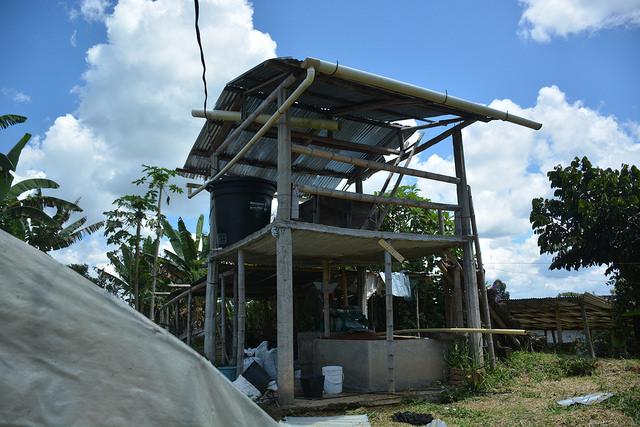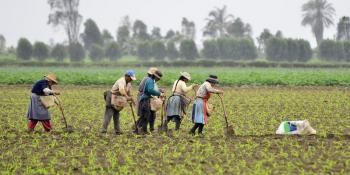Holding on to water through climate-smart agriculture

As we celebrate World Water Day, we reflect on how returning to nature for answers can bring water security to farmers across the world.
Water keeps us alive. We use it daily, in a myriad of ways. Some common uses are obvious, but others are harder to see, like the hidden water in our food—the water going into the vegetables and fruits on our tables. For farmers across the world, having the right amount of water for their crops can make or break their livelihoods, and ultimately decides food security at micro and macro levels.
Agriculture is currently responsible for about 70% of global water withdrawals, with most of it being used for irrigation. And while the jury is still out on the exact figures for future demand for water, it is estimated that global demand will increase by 20-30% by 2050 (UN Water Development Report 2018) as the world population, and its demand for food, increase. According to the UN, the main opportunities to increase agricultural productivity lie in “rain fed systems that account for the bulk of current agricultural production and family farming, providing the greatest livelihood and poverty reduction benefits”. But changing climate conditions will alter hydrological systems across many regions, as rainfall patterns are predicted to become increasingly variable and extreme weather events more frequent.
Water use 2.0
The CGIAR Research Program on Climate Change, Agriculture and Food Security (CCAFS) focuses on climate-smart agriculture (CSA) to help small farmers adapt to and mitigate future climate change in a manner that ensures secure livelihoods. Maintaining and improving water management plays a critical part in strengthening agricultural production in Climate-Smart Villages (CSVs) across the five regions where we work. And in many cases, this involves looking at nature-based solutions that can serve as the foundations for water-smart practices.

Solar water pumps are used for drip irrigation. Photo: Adam Ojdahl (IWMI)
“The CCAFS Climate-Smart Village network, which spans diverse agro-ecological systems in 20 countries, is a valuable testing ground that allows us to test and evaluate together with farming communities how efficient water-smart management interventions are for each local context,” says Osana Bonilla-Findji, Science Officer for CCAFS’ Climate Smart Agricultural Practices Flagship. “These practices increase water use efficiency and management of its availability over time, and also support decision making for agricultural planning.”
Catching the rain
CSA relies on rainfall itself to fight its increasingly erratic behavior, by making the most of every drop, and storing excess for use in times of need. Rainwater harvesting can secure water resources in regions with irregular rainfall and in those facing increasing precipitation variability. In this approach, farmers channel rainwater to reservoirs or tanks for storage during the rainy season, and then use the stored water when conditions are dry. Catchment areas, planting basins or earth dams can also be used. These practices allow them to produce crops that would otherwise require bringing water from afar, or that would not survive at all.
We’re harvesting water. We have a water tank above the garden, working with the help of gravity. Before, in times of drought, we had to carry water for anything we might have needed it for, including irrigation. And sometimes we don’t have rain for seven months. Now things are different.”
– Ana Rivera, farmer in Cauca CSV, Colombia

Water tank for rainwater harvesting in Cauca CSV, Colombia. Photo: Alexandra Popescu (CCAFS)
Solar water pumps for irrigation are also on the rise; in India, the government has granted 21.8 billion USD to provide 1.75 million off-grid agricultural solar pumps. The pumps serve a double purpose: they help farmers irrigate their land, and allow them to sell any surplus energy they have.
Drop by drop
Drip irrigation is a widespread solution for farmers in CSVs, allowing them to efficiently supply the amount of water their home gardens and crops need. With this technology, the water drops only wet the plants’ root zone, reducing runoff and evaporation and preventing nutrients from washing away. This can substantially increase crop and tree productivity while saving water, both key elements of sustainable agriculture in areas confronting increasing climate variability.
I planted a monoculture of cassava, which required inputs every single year, and caused soil erosion and degradation. Now, I have converted 1.2 ha of cassava to fruit trees in a spiral pattern—which is similar to contour planting—with Arachis pintoi, and applied drip irrigation and a pond to store water. I believe that this practice will provide me with higher income, help me adapt to drought, and reduce soil erosion and soil moisture loss”.
– Duong Duc Thai, My Loi CSV, Vietnam
But better irrigation doesn’t stop here. Farmers can also use sprinkler technology, Alternate Partial Rootzone Irrigation, or alternate wetting and drying, which reduces water, costs and methane emissions for rice.
Growth, and protection
Conservation agriculture—another approach relevant to CSA—is gaining momentum in rural communities around the world. Conserving the material base that allows for agriculture to continue is cruical: taking care of soil and water means taking care of crops. CSA bets on a less invasive approach and lets nature do some of the work. Farmers in CSVs, for instance, are relying on agroforestry systems, growing annual or perennial crops in alongside trees, shrubs and pastures. In El Tuma-La Dalia CSV in Nicaragua, Wilfred Salgado manages his coffee bushes under the shade of a variety of trees and banana palms, which not only improves the quality of the coffee cherries, but also increases soil drainage and its capacity to hold water.
African farmers continue using traditional knowledge and practices through zai, a planting technique that involves placing compost and manure over seeds in shallow pits, thereby improving water and nutrient use, and reducing runoff and nutrient depletion in dry areas.
Read more:
- Website: CSA Guide
- Blog: What's so smart about climate smart agriculture?
- Blog: Realizing sustainable land and water management in farming under climate change
- Blog: Climate-smart agricultural initiatives set to scale in India
- Blog: Small but getting stronger: coffee and cocoa, the climate-smart way
- Presentation: Innovations in water management for agriculture: New pathways, future challenges
Alexandra Popescu is the Communication Officer for CCAFS Latin America.



